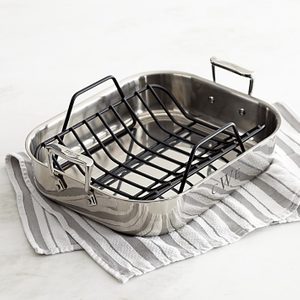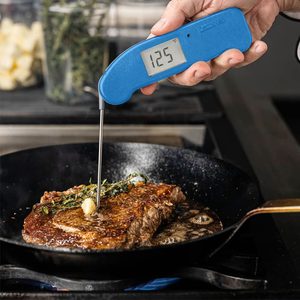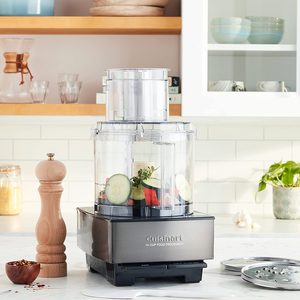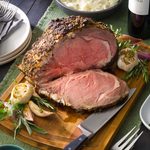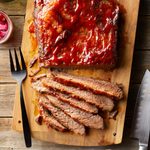Learn How to Cook Prime Rib (That’s Way Better Than Any Steakhouse)

Learning how to cook prime rib can be intimidating, but all you need is the right technique.
Our editors and experts handpick every product we feature. We may earn a commission from your purchases.
When it comes to meat, our everyday lineup is pretty average: chicken breast, pork tenderloin, ground beef—you get the idea. Although you can make some pretty spectacular dinners with these ingredients, they’ll never be met with the same kind of celebratory excitement that comes from roasting a big, juicy cut like prime rib for Christmas dinner.
Learn how to cook prime rib with our best tips and tricks. Follow along and you’ll be carving a celebration-worthy roast in no time! P.S. These are some of the places you can order Christmas dinner from—and everyone will think it’s homemade!
What Makes Prime Rib, uh, Prime?
Prime rib is often confused with ribeye steak, another one of the best cuts of beef. The main difference is that prime rib is cooked as a whole roast that’s sliced before serving, and it almost always contains bones. Ribeye is a steak that’s cut off of the standing rib roast. It may be sold as bone-in or boneless steaks.
The standing rib roast (or prime rib roast) is sourced from the rib section of a cow, an area that’s extra tender and marbled with fat. Marbling is the streaky white fat that runs throughout a good cut of meat. This type of meat packs plenty of flavor on its own, so it doesn’t need to be marinated.
Choosing Your Cut of Prime Rib
Go for bone-in prime rib when planning your Christmas meal. The bones help control the meat’s temperature, insulating the meat as it cooks. The extra surface area on bone-in cuts prevents the temperature from rising too quickly, ensuring your roast is nice and juicy. It will take longer to cook, but it’s worth it!
If your butcher has strung your meat, go ahead and leave the twine on while you cook. This simply keeps the ribs attached to the roast. Just snip it off before you serve. Here are some more tips for getting the best deals from the butcher.
How Many People Does Prime Rib Serve?
We love serving prime rib for Christmas because it’s a main dish that feeds a lot of people. Taste of Home Deputy Culinary Editor James Schend says, “I usually aim for one rib for every two guests.” He goes on to say that if there are a lot of side dishes, you can probably get away with one rib for every three guests.
Picking Your Pan
Most rib roast recipes call for you to lug out a large roasting pan, but a 13×9-inch dish works, too. If you’re opting for this rack-free baking pan, however, layer the bottom with veggies and place your roast on top. We’d recommend a mirepoix (pronounced: MEER-pwah), a fancy French term for coarsely chopped onions, carrots and celery. The veggies will cook gently and help form a flavorful sauce from your drippings.
Now that you know the basics, let’s get cooking!
How to Cook Prime Rib
Ingredients
- 1 large shallot, coarsely chopped
- 6 garlic cloves, quartered
- 3 tablespoons minced fresh rosemary or 1 tablespoon dried rosemary
- 2 tablespoons minced fresh oregano or 2 teaspoons dried oregano
- 2 tablespoons minced fresh thyme or 2 teaspoons dried thyme
- 2 tablespoons minced fresh sage or 2 teaspoons rubbed sage
- 2 tablespoons olive oil
- 3 teaspoons pepper
- 1 teaspoon salt
- 1 bone-in beef rib roast (4 pounds) brought to room temperature
- Mirepoix (optional): one onion, a few carrots and a handful of celery, coarsely chopped
Tools You’ll Need
- Roasting Pan: Using a roasting pan is the best way to cook prime rib. These large, oven-safe pans have built-in racks, which prevents a roast from touching the bottom of the pan. That promotes even heating and allows the pan drippings to fall through the rack onto the vegetables below.
- Meat Thermometer: A meat thermometer is the best way to know—not guess—when your roast is finished cooking. Probe the roast in the thickest part of the meat and be sure you don’t touch any bones for the most accurate reading.
- Food Processor: We love having a food processor on hand to make prep tasks easier, like chopping mirepoix.
Directions
Step 1: Season the meat
Preheat the oven to 350°F. While it’s warming up, start the seasoning. Begin by placing the shallot, garlic and herbs into a food processor; cover and pulse until finely chopped. Then add in oil, pepper and salt. Cover and process until blended. This will “wet” down the seasoning so it’s easy to spread on your rib roast.
Rub the mix liberally over standing rib roast. Let sit at room temperature about 30 minutes before roasting. This takes the chill off the meat surface, which aids in browning.
Test Kitchen Tip: For can’t-miss flavor, cut slits into the roast and stuff with minced garlic.
Step 2: Set up the pan
Fill a roasting pan with the mirepoix and rest the meat on the rack. Place the prime rib fat side up, which will bathe the roast in its own flavorful juices as it cooks.
Test Kitchen Tip: Be sure the pan you choose isn’t too large, which will cause the drippings to evaporate.
Step 3: Roast the prime rib
Bake the meat until its internal temperature is 5 to 10° below your desired doneness. We prefer prime rib that’s somewhere between rare and medium-rare. That’ll take somewhere between 1-3/4 and 2-1/4 hours.
| Doneness |
Temperature |
| Medium-Rare | 135° |
| Medium | 140° |
| Medium-Well | 145° |
Step 4: Let the prime rib stand
You may be tempted to cut into your steamy, herb-crusted roast, but let it rest for at least 15 minutes. Cutting into meat too early is one of the biggest mistakes people make when cooking steak. The resting period gives the juices time to absorb into the meat. For larger cuts, you might want to let stand for 5 minutes longer.
Step 5: Carve the prime rib and enjoy
If the bones are still attached, carve ’em off with a sharp knife. The easiest way to do this is to lift the roast onto its end using its protruding bone as a handle. Then glide the knife along the curve of the bone, detaching it from the rest of the meat. With the bones removed, you’ll be able to slice roast as thick (or thin) as you’d like. This 4-pound roast will serve about eight people.
Test Kitchen Tip: While we often recommend that you cut against the grain for several other types of steak, it’s not necessary with prime rib. Because the meat is so tender on its own, and the direction of the grain is hard to detect, it’s not something you need to worry about. You’ll end up with tender, juicy prime rib no matter how you cut.
How to Serve Prime Rib
You can carve prime rib tableside if you like, but we prefer to slice it and cascade the pieces on a large platter. It makes an impressive statement when placed in the middle of the Christmas table! If your prime rib is done before you’re ready to serve, wait to slice it. Keep it warm by tenting the roast with a piece of aluminum foil.
Looking for the best side dishes to serve with prime rib? Any side dish that goes well with steak will work well here. Look to classic potato dishes like mashed potatoes or potatoes au gratin, vegetables like air-fryer Brussels sprouts or broccolini, classic salads like Caesar salad or rich sides like mac and cheese or creamed corn.
The Best Sauces to Serve with Prime Rib
Prime rib tastes fantastic on its own, but that doesn’t mean it can’t be improved with a tasty sauce. These sauces are perfect for serving with prime rib for Christmas dinner, but they’re also fantastic for leftover sandwiches.
- Zesty horseradish sauce: In a small bowl, beat 1/2 cup heavy whipping cream until stiff peaks form. Fold in 1/4 cup fresh grated horseradish root, 1/2 teaspoon Dijon mustard and 1/4 teaspoon salt. Cover the sauce and refrigerate for 15 minutes before serving.
- Au jus: This French term simply translates to “with juice,” referring to the natural juices from the meat as it roasts. To make au jus, gather up the drippings from the bottom of the pan and whisk in about 1-1/2 cups of hot beef broth. Transfer the au jus to a gravy boat to serve.
- Red wine mustard sauce: This elegant sauce is easy to make but takes your roast to the next level. Remove the roast and drippings from the roasting pan and place it over medium heat on the stovetop. Add 2 tablespoons unsalted butter and 2 medium shallots, minced, and cook for 1 minute until softened. Add 1 cup red wine and cook until mostly reduced, about 3 minutes. Finish the sauce with 2 cups low-sodium beef broth, 2 tablespoons Dijon mustard and a few fresh herb sprigs (like rosemary or thyme). Simmer the sauce for 5 minutes, until reduced to 1-1/2 cups. Season with salt and pepper to taste and transfer to a gravy boat to serve.
- Gremolata: Freshen up your prime rib with a bright gremolata sauce. Finely chop 1 bunch Italian parsley and combine with the zest of 2 lemons and 1 minced garlic clove. Store in an airtight container in the refrigerator until ready to serve.
How to Store Prime Rib
If you love a good roast beef sandwich, you’re in luck! You can keep prime rib leftovers in the fridge for up to 4 days or in the freezer for up to 4 months. Whichever storage method you choose, tightly wrap the meat in plastic first. It tastes best (and stays juiciest) when freshly sliced, so we recommend storing the roast whole.
To thaw prime rib, move the roast to the refrigerator 24 hours before you plan to dig in.

